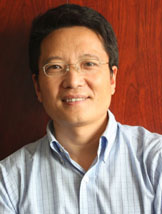
Triply degenerate point (TP) fermions in tungsten-carbide-type materials (e.g., MoP), which represent new topological states of quantum matter, have generated immense interest recently. However, the TPs in these materials are found to be far below the Fermi level, leading to the TP fermions having less contribution to low-energy quasiparticle excitations. Here, we theoretically predict the existence of TP fermions with TP points close to the Fermi level in a new system, i.e., trigonal layered PtBi2, by ab initio calculations, and experimentally verify the predicted band topology by magnetotransport measurements under high magnetic fields up to 40 T. Analyses of both the pronounced Shubnikov–de Haas and de Haas–van Alphen oscillations reveal the existence of six principal Fermi pockets. Our experimental results, together those from ab initio calculations, reveal the interplay between transport behaviors and unique electronic structures, and support the existence of TP fermions in trigonal layered PtBi2. When the system was apllied a high pressure, a pressure-induced superconductivity is observed near 10 GPa and remains almost unchanged up to 50 GPa. In addition, as a new member of FLEET,I will also give an introduction on the China high magnetic field laboratory (CHMFL) of the Chinese Academy of Science in Hefei and hope to seek potential collaborartion research between FLEET and CHMFL.
About the speaker
Professor Mingliang Tian is vice-director of the Chinese Academy of Science’s High Magnetic Field Laboratory in Anhui province, China, where his group studies low-dimensional electronic systems and artificial nanostructures such as iron-based superconductors, bismuth nanowires and nanoribbons, as well as topological insulators and skyrmions. FLEET’s Prof Lan Wang has worked with Professor Tian’s group in the past to study 2D magnetic materials, vdW ferromagnetic heterostructures and topological condensed matter systems.
